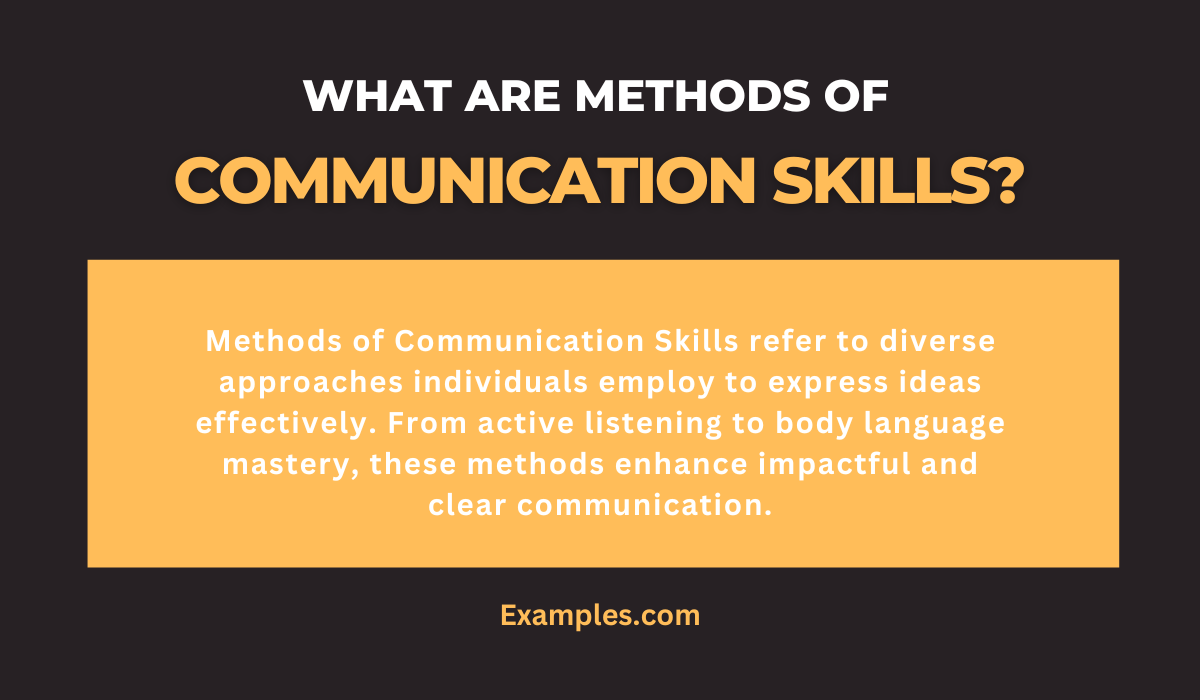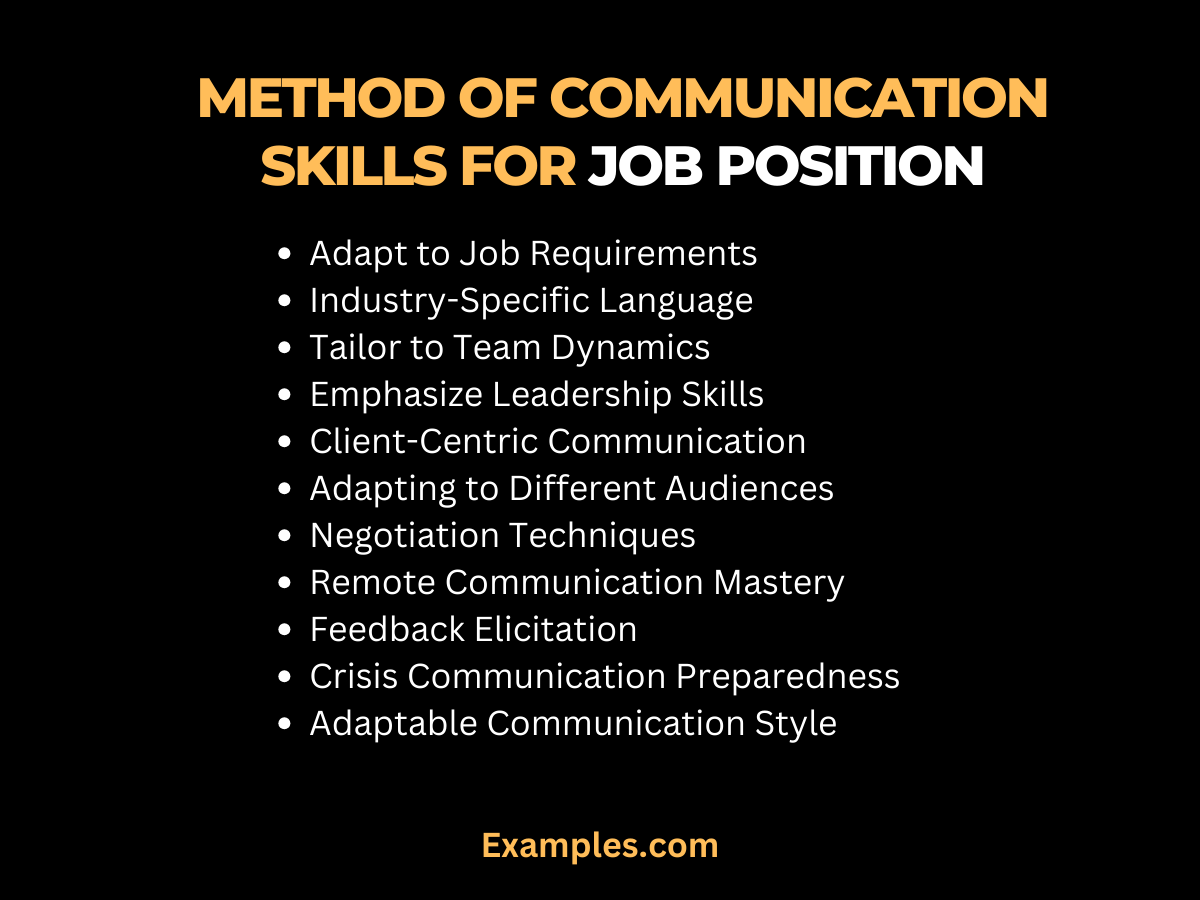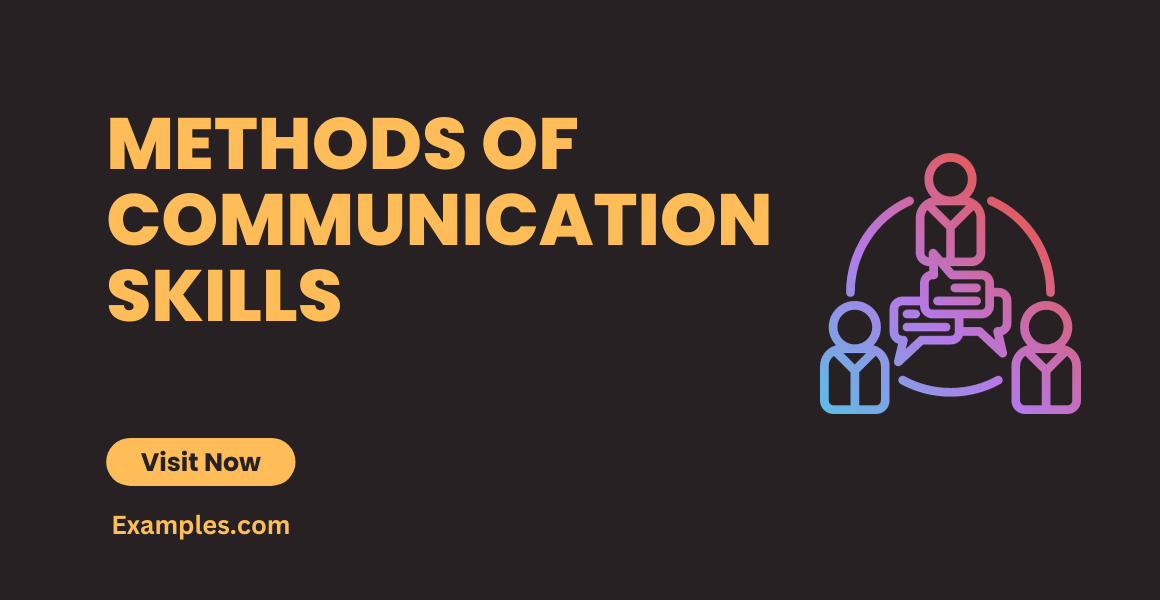29+ Methods Of Communication Skills Examples
Embark on a transformative journey with our “Methods Of Communication Skills – Complete Guide with Examples.” Delve into the intricacies of effective communication, exploring a diverse range of methods and strategies. This comprehensive guide is enriched with vivid communication examples, offering valuable insights to enhance your interaction skills at work, in relationships, and beyond. Elevate your communication prowess and navigate diverse scenarios with confidence and finesse.
What are Methods Of Communication Skills?
Methods of Communication Skills encompass the diverse approaches individuals use to convey thoughts, ideas, and information effectively. In simple terms, it refers to the various techniques employed for clear expression, whether verbal, nonverbal, or written. This includes the art of active listening, adept use of body language, and choosing the right channels for written communication. Understanding these methods is crucial for fostering successful interpersonal relationships, navigating professional environments, and ensuring that messages are accurately conveyed and received. Mastering these skills empowers individuals to connect authentically and navigate diverse communication scenarios with confidence and impact.

30 Methods Of Communication Skills Examples
Unlock the power of effective communication with these 30 Methods of Communication Skills examples. From workplace relationships to home dynamics, these techniques encompass diverse scenarios, enhancing your ability to convey messages with impact and clarity.

- Active Listening: Demonstrate attentive listening by paraphrasing and responding to ensure understanding in conversations.
- Body Language Mastery: Use confident posture and gestures to underscore your points, enhancing the nonverbal aspect of communication.
- Visual Aids Utilization: Enhance presentations with visuals like graphs and images to complement verbal explanations for better understanding.
- Empathetic Communication: Express understanding and empathy in challenging conversations to build stronger connections with others.
- Effective Use of Pauses: Strategically pause between ideas to emphasize key points and allow the audience to absorb information.
- Storytelling Expertise: Weave compelling narratives to make abstract concepts relatable and engage your audience effectively.
- Feedback Elicitation: Encourage open and constructive feedback to foster continuous improvement and mutual respect in the workplace.
- Nonverbal Communication: Utilize facial expressions and gestures to convey emotions, adding nuance to your verbal communication.
- Negotiation Mastery: Craft persuasive arguments, actively listen, and use nonverbal cues for successful negotiation in professional settings.
- Cross-Cultural Communication: Adapt your communication style to diverse cultural contexts to ensure universal understanding.
- Inclusive Language: Make use of language that includes everyone, fostering a sense of connection and engagement.
- Adaptive Language Style: Tailor language complexity to your audience’s comprehension level, ensuring universal understanding.
- Conflict Resolution Dialogue: Navigate conflicts by actively listening, expressing understanding, and using assertive communication for resolution.
- Question Handling: Address questions adeptly to demonstrate expertise, fostering dynamic exchanges in professional settings.
- Visualization Communication: Use descriptive language to create vivid mental images, aiding understanding in various communication contexts.
- Interactive Q&A Session: Encourage audience participation through questions and answers, creating a dynamic and engaging atmosphere.
- Varied Vocal Intonation: Add emphasis and emotion to your words through a dynamic range of vocal intonation for sustained audience interest.
- Crisis Communication Skills: Effectively convey a sense of control and assurance in crisis situations through clear and transparent communication.
- Effective Team Briefings: Conduct team briefings with clarity and enthusiasm, ensuring everyone understands their roles.
- Leadership Communication: Exemplify leadership through inspirational communication, instilling confidence and inspiration in your team.
- Networking Events Navigation: Navigate networking events with engaging conversation starters and concise self-introductions.
- Project Status Updates: Deliver project updates with a focus on key milestones, ensuring team members are informed and engaged.
- Effective Time Management: Maintain a well-paced delivery to ensure each segment of your communication receives adequate attention.
- Email Communication Clarity: Craft emails with clarity and brevity, ensuring messages are easily understood in written form.
- Engaging Opening Hook: Capture attention with a captivating opening, setting the stage for a compelling presentation.
- Confident Eye Contact: Maintain eye contact to convey sincerity and confidence, establishing a direct connection with your audience.
- Professional Networking: Foster a sense of connection in remote teams through clear and regular communication, maintaining cohesion.
- Cross-Functional Communication: Bridge communication gaps between departments by simplifying complex concepts for seamless understanding.
- Leadership Development: Nurture leadership qualities by guiding and inspiring others through compelling communication.
- Adaptability Expression: Effectively communicate changes by emphasizing positive aspects, addressing concerns, and maintaining transparency.
Methods Of Communication Skills Examples Technique
Explore advanced Methods of Communication Skills through diverse techniques that enhance your expressive capabilities. From the art of active listening to utilizing effective body language, these methods empower you to communicate with impact, clarity, and confidence. Elevate your interpersonal connections and professional communication through these proven techniques, fostering an environment of understanding and collaboration.
- Mirroring Technique: Reflect the body language and speech patterns of your conversation partner to establish rapport and enhance understanding.
- Chunking Information: Break down complex information into smaller, digestible chunks for clearer communication and improved retention.
- Fogging Method: Maintain composure during conflicts by agreeing with some aspects of criticism and calmly addressing concerns.
- Reflective Listening: Paraphrase and repeat what you’ve heard to confirm understanding, fostering deeper connections in conversations.
- Role Reversal: Switch roles with your conversation partner to gain insights into their perspective, enhancing empathy and communication.
- Mindful Communication: Stay present and focused in conversations, avoiding distractions to ensure meaningful and effective communication.
- Power Posing: Utilize confident body postures to enhance self-assurance and project authority in professional and personal interactions.
- The Rule of Three: Present information in sets of three to enhance clarity, understanding, and retention in your communication.
- Visual Metaphors: Use visual metaphors to illustrate complex ideas, making them more accessible and engaging for your audience.
- Silence as a Tool: Strategically use pauses for emphasis, allowing your audience to absorb information and fostering a dynamic presentation.
Methods Of Communication Skills Examples in Work Relationship
In professional settings, effective communication is paramount. Learn key Methods of Communication Skills tailored for work relationships. Master the art of negotiation, navigate conflicts with diplomacy, and foster collaborative environments. These examples equip you with the skills to build strong professional connections, enhance teamwork, and thrive in the workplace.
- Conflict Resolution Framework: Address workplace conflicts by identifying issues, expressing emotions, and collaboratively finding solutions.
- Peer Recognition: Acknowledge and appreciate the contributions of colleagues, fostering a positive and collaborative work environment.
- Collaborative Decision-Making: Involve team members in decision-making processes, ensuring diverse perspectives and fostering a sense of ownership.
- Active Feedback Loop: Establish a continuous feedback system to address concerns, celebrate achievements, and promote ongoing professional development.
- Clear Delegation: Communicate expectations clearly when delegating tasks, ensuring a shared understanding and preventing misunderstandings.
- Cross-Functional Communication: Bridge communication gaps between departments by facilitating open and transparent information exchange.
- Team-building Exercises: Engage in team-building activities to strengthen bonds, enhance communication, and foster a positive work culture.
- Conflict Prevention Strategies: Implement proactive measures to identify and address potential conflicts before they escalate within the workplace.
- Open-door Policy: Encourage an environment of open communication by maintaining an accessible and approachable demeanor for your team.
- Feedback Culture: Cultivate a culture where giving and receiving feedback is embraced, promoting continuous improvement and professional growth.
Methods Of Communication Skills Examples at Home
Effective communication is the bedrock of harmonious home environments. Discover Methods of Communication Skills designed for domestic settings. From conflict resolution to empathetic communication, these examples provide valuable insights for fostering understanding, connection, and positive dynamics within your home. Enhance your family relationships and create a supportive, communicative atmosphere for shared growth and well-being.
- Family Meetings: Conduct regular family meetings to discuss concerns, share updates, and foster open communication among family members.
- Empathetic Listening at Home: Listen actively to family members’ concerns, validating their emotions and creating a supportive home environment.
- Positive Reinforcement: Celebrate achievements and positive behaviors within the family, reinforcing a culture of appreciation and encouragement.
- Conflict Resolution Conversations: Handle conflicts within the family by addressing issues calmly, expressing feelings, and collaboratively finding solutions.
- Establishing Boundaries: Communicate and respect personal boundaries within the family, fostering a sense of individual autonomy and mutual respect.
- Quality Time Communication: Use dedicated quality time to engage in meaningful conversations, strengthening family bonds and connection.
- Clear Communication of Expectations: Articulate expectations regarding chores, responsibilities, and family commitments to avoid misunderstandings.
- Expressing Gratitude: Foster a culture of gratitude by regularly expressing appreciation for the efforts and contributions of family members.
- Teaching Communication to Children: Instill effective communication habits in children by modeling positive behavior and providing guidance on expressing emotions.
- Creating a Safe Space: Establish an environment where family members feel safe to share thoughts, feelings, and concerns without fear of judgment.
What are Methods Of Communication Skills for Interviews?
Effective communication is pivotal during interviews. Mastering specific Methods of Communication Skills can significantly impact your performance:
- Active Listening: Demonstrate attentiveness, paraphrase, and respond thoughtfully to showcase your engagement.
- Nonverbal Cues Interpretation: Understand and utilize nonverbal cues to gauge the interviewer’s reactions and tailor your responses.
- Clarity in Expression: Articulate your thoughts clearly, avoiding jargon, ensuring your responses are easily comprehensible.
- Body Language Mastery: Employ confident posture and gestures, projecting assurance and professionalism.
- Adaptability in Communication: Adjust your communication style based on the interviewer’s cues and the nature of the questions.
- Storytelling Technique: Weave compelling narratives to illustrate your experiences and skills effectively.
- Question Handling Skills: Address queries with poise, providing comprehensive yet concise responses.
- Empathetic Communication: Express understanding and empathy when discussing challenges or past experiences.
- Visual Communication: Use visual aids, like a portfolio, to complement verbal responses and showcase your achievements.
- Closure Confidence: Conclude the interview with a confident closing statement, expressing gratitude and reiterating your interest.
What are Methods Of Communication Skills Strategies?
Developing effective communication strategies is key to successful interaction in various contexts. Here are valuable strategies encompassing Methods of Communication Skills:
- Tailoring Your Message: Adapt your communication style based on the audience, ensuring your message resonates effectively.
- Feedback Elicitation: Encourage open and constructive feedback to refine your communication approach continually.
- Audience Analysis: Understand the demographics, interests, and knowledge level of your audience to tailor your message appropriately.
- Message Clarity: Convey your message clearly and concisely, avoiding ambiguity and ensuring a seamless understanding.
- Crisis Communication Tactics: Develop strategies for effective communication during challenging or crisis situations, ensuring clarity and composure.
- Engagement Techniques: Foster engagement through interactive elements, questions, and anecdotes, creating a participatory atmosphere.
- Multichannel Communication: Utilize various communication channels, including written, verbal, and visual, for comprehensive and impactful messaging.
- Conflict Resolution Strategies: Navigate conflicts with diplomacy, using assertive communication to find common ground and resolution.
- Strategic Pauses: Integrate strategic pauses during communication to emphasize key points and allow for better absorption of information.
- Adaptive Language Use: Tailor your language complexity to the audience, ensuring universal understanding and engagement.
What are Methods Of Communication Skills for Job Position?
In the professional realm, mastering Methods of Communication Skills is crucial for career success. Tailoring your communication techniques to fit job positions is essential. Here’s a guide to navigate the intricacies:

- Adapt to Job Requirements:
- Align communication methods with specific job requirements, emphasizing skills relevant to the position.
- Industry-Specific Language:
- Familiarize yourself with industry-specific language, ensuring effective communication with colleagues and superiors.
- Tailor to Team Dynamics:
- Adapt communication methods to complement team dynamics, promoting seamless collaboration and understanding.
- Emphasize Leadership Skills:
- If in a leadership role, focus on communication methods that inspire, motivate, and guide the team effectively.
- Client-Centric Communication:
- For client-facing positions, hone methods that establish rapport, actively listen, and address client needs with precision.
- Negotiation Techniques:
- Develop negotiation skills, especially for roles requiring contract discussions, vendor management, or sales responsibilities.
- Remote Communication Mastery:
- Embrace effective remote communication methods for positions that involve virtual collaboration, emphasizing clarity and engagement.
- Feedback Elicitation:
- Cultivate an environment of open feedback, ensuring effective communication channels for continuous improvement.
- Crisis Communication Preparedness:
- Equip yourself with crisis communication methods to navigate challenging situations, demonstrating composure and control.
- Adaptable Communication Style:
- Possess an adaptable communication style to suit diverse job responsibilities, showcasing versatility in your skill set.
Tips for Effective Methods Of Communication Skills
Refining your Methods of Communication Skills is an ongoing process. Here are tips to enhance your effectiveness in various communication scenarios:
- Active Listening:
- Engage in active listening to truly understand others, fostering more meaningful and productive conversations.
- Strategic Use of Body Language:
- Leverage nonverbal cues strategically, enhancing the impact of your message and creating a positive impression.
- Choose the Right Channel:
- Select communication channels wisely, considering the nature of the message and the preferences of your audience.
- Empathetic Communication:
- Cultivate empathy in your communication, acknowledging others’ perspectives and fostering stronger connections.
- Clear and Concise Messaging:
- Craft messages that are clear, concise, and easily digestible, ensuring effective communication without ambiguity.
- Tailor Communication to Your Audience:
- Adapt your communication style to suit your audience, whether it’s colleagues, clients, or superiors, ensuring better reception.
- Conflict Resolution Techniques:
- Equip yourself with effective conflict resolution methods, promoting a harmonious work environment and preventing escalated issues.
- Effective Use of Technology:
- Stay updated on communication technologies, utilizing them effectively to streamline processes and enhance overall efficiency.
- Continuous Learning:
- Embrace a mindset of continuous learning, seeking feedback and refining your communication methods based on experience.
- Feedback Loop Creation:
- Establish a feedback loop in your communication, encouraging open dialogue and fostering an environment of improvement and growth.
In conclusion, this comprehensive guide unveils the intricacies of Methods of Communication Skills, offering a rich array of examples and practical insights. From workplace dynamics to interpersonal relationships, masterful communication is pivotal. Apply these methods to navigate professional challenges, build robust connections, and foster an environment where effective communication becomes a cornerstone for personal and career success.



